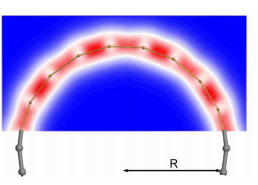One of the most rock-solid principles of physics is the conservation of energy, which simply means that energy can neither be created nor destroyed. Energy can slosh around and change forms. It can convert from the potential energy of a drawn bow to the kinetic energy of an arrow in flight to the sound energy of the "thwack" as the arrow hits its target. If you learn nothing else in a physics class, you learn that energy is conserved.
Thus it may be a little disconcerting to later learn that this principle isn't quite as cut and dried as you were originally taught. In the quantum realm, energy conservation isn't absolute. It turns out that in the world of the ultra-small, energy can not be conserved as long as the time that it isn't conserved is brief. Further, the greater the unconserved energy, the shorter the time during which this weird state of affairs can happen.
To understand how this works, think about how you might go about lending money to a fiscally unreliable friend. If he asked to borrow a dollar, you'd give him the money and not worry too much about when you'd get it back. The loan is small, and if you didn't see the money for a long time, it would probably be OK. On the other hand, if you loaned him $100, you might want to be repaid in a week or so. If you loaned him $100,000, you'd probably want to get that money back right away.
The subatomic universe is the same way, constantly borrowing and paying back energy. Most of the time, these "energy loans" are small. Big ones are rare and very short-lived. The key word here is "rare."
While the leviathan LHC at CERN can study high energies through pure brute force, there is another way to investigate high-energy phenomena: Study lots and lots of lower-energy collisions in the hopes of finding one "in the act" of temporarily borrowing a lot of energy from the vacuum of the universe. If you are lucky, you can see some very high-energy phenomena this way.
Fermilab's shift from experiments using high-energy beams to those using high-intensity beams plays right into this approach. The best way to see rare phenomena is to study lots and lots of interactions, and the best way to do that is to use extremely high-intensity beams.
Although the energy books have to be balanced at the end of the day, or, more appropriately, at the end of the collision, very rare phenomena can pop up due to the occasional rare borrowing of lots of energy. In fact, it is virtually certain that future experiments at Fermilab using low-energy, high-intensity beams will be able to make some physical measurements that are beyond the reach of the LHC.
—Don Lincoln
Want a phrase defined? Have a question? E-mail today@fnal.gov.





